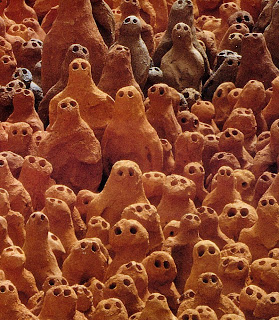Most incoming Foundation course students receive open briefs with a fairly abstract stimulus. These are intended to get you thinking, and perhaps move on quite quickly to subject areas some distance from your original starting point. One given topic was 'Functional Skills Maths' - so where could you go?
 To start off basically, a number of artists have used numbers. Demuth, Johns, and Indiana to name three. But you could move on quickly from that to more abstract uses of numbers.
To start off basically, a number of artists have used numbers. Demuth, Johns, and Indiana to name three. But you could move on quickly from that to more abstract uses of numbers. Peter Greenaway did an amazing work called The Tulse Luper suitcases, all based around the number 92, the atomic number of uranium, which was discovered the year Luper was born.
Tulse Luper is a fictitious character, an ornithologist, who travels the world, collection, packing and unpacking suitcases, and then leaving them in appropriate and inappropriate places. Some were stolen, some were arranged to be stolen, others were meant to be re-found, and then brought back together to go on display - 92 of them. He also did the films Drowning by numbers, and a Z and two noughts.
You could also look at using ice as an installation material, and see how it reduces in size, and alters in chape. Great with spotlights behind it in a pitch black space.
More obviously you could explore the idea of painting by numbers, or aspects of the Golden Section and the Fibonacci sequence which underpins a great deal of art and architecture.
 |
| Gormley: Field |
Multiplication or multiples are a staple in art, see, for example, Gormely or Tunick, or think about division, folding paper, dividing objects into constituent parts, etc.
Since you are dealing with numbers, you could look at key dates, 9/11; 7/7, or receipts. One student did an entire project around all of her receipts which gave insight into how she lived. Like a numerical diary.
Theo Jansen's creatures might not seem mathematical at first glance, but work on the binary system.
You could, on that theme, also look at non western mathematical systems - the sumerian system, metrology, etc.

























